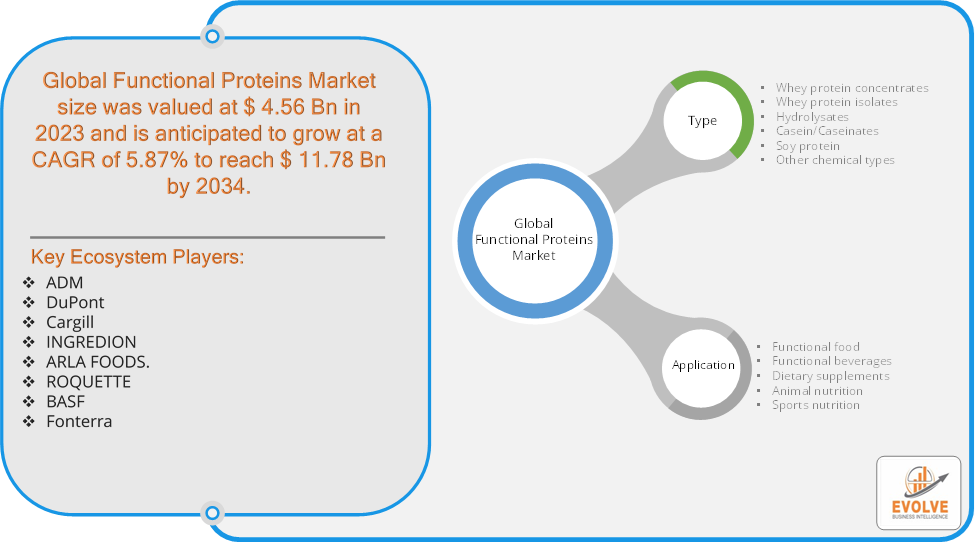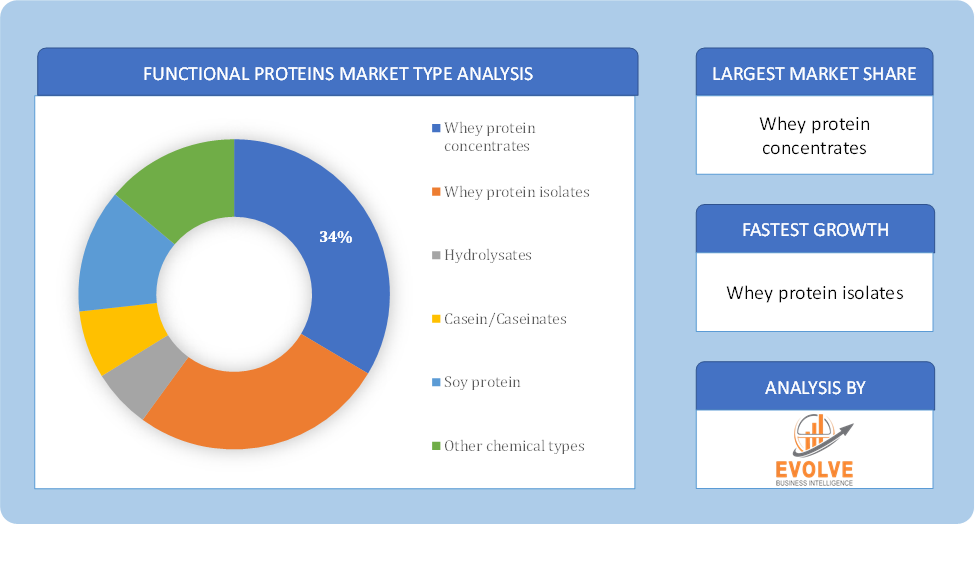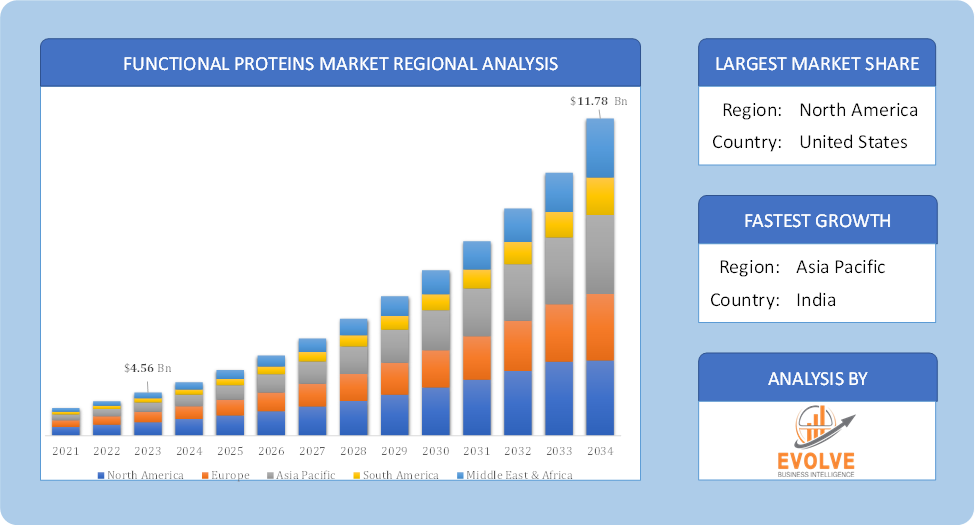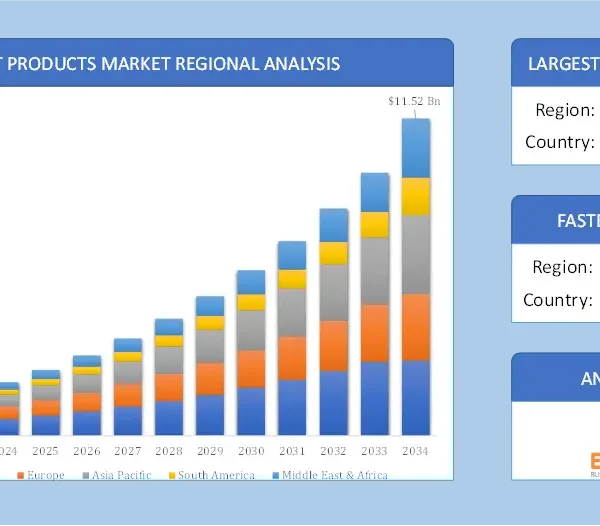Functional Proteins Market Analysis and Global Forecast 2024-2034
$ 1,390.00 – $ 5,520.00Price range: $ 1,390.00 through $ 5,520.00
Functional Proteins Market Research Report: Information By Type (Whey protein concentrates, Whey protein isolates, Hydrolysates, Casein/Caseinates, Soy protein, Other chemical types) By Application (Functional food, Functional beverages, Dietary supplements, Animal nutrition, Sports nutrition), and by Region — Forecast till 2034
Page: 145
Functional Proteins Market Overview
The Functional Proteins Market size accounted for USD 4.56 Billion in 2023 and is estimated to account for 6.12 Billion in 2024. The Market is expected to reach USD 11.78 Billion by 2034 growing at a compound annual growth rate (CAGR) of 5.87% from 2024 to 2034. The functional proteins market refers to the global industry involved in the production, processing, and distribution of proteins that have specific health benefits beyond their basic nutritional value. These proteins are often incorporated into food and beverage products, dietary supplements, and other consumer goods.
The functional proteins market is driven by various factors, including increasing consumer awareness of health and wellness, growing demand for convenient and nutritious food products, and the rise of plant-based diets.
Global Functional Proteins Market Synopsis
 Functional Proteins Market Dynamics
Functional Proteins Market Dynamics
The major factors that have impacted the growth of Functional Proteins Marketare as follows:
Drivers:
Ø Growing Demand for Protein-Rich Diets
Protein consumption is on the rise, particularly for individuals focused on fitness, weight management, and muscle recovery. Functional proteins are a key source of high-quality, digestible proteins, which is increasing their use in dietary supplements and functional food products. The growing market for functional foods, which provide additional health benefits, is directly linked to the increasing use of functional proteins as ingredients. These proteins are incorporated into a wide range of products such as protein bars, snacks, dairy products, and meal replacements.
Restraint:
- Perception of High Production Costs and Texture Challenges
The extraction, purification, and processing of functional proteins, especially from non-traditional or plant-based sources, can be expensive. These costs are often passed on to consumers, making functional protein products less affordable compared to conventional alternatives and Some functional proteins, particularly plant-based proteins, can have an undesirable taste or texture, which affects consumer acceptance. Manufacturers face challenges in masking the off-flavors or gritty textures associated with certain protein types, particularly in ready-to-eat or drink products.
Opportunity:
⮚ Rising Demand for Plant-Based Proteins
With the growing trend toward plant-based diets and veganism, there is a significant opportunity for plant-based functional proteins such as pea, soy, rice, and hemp. Manufacturers can expand their portfolios to meet the demand for sustainable, animal-free protein alternatives, especially in functional foods and beverages. The demand for sustainably sourced, clean-label, and organic products is growing. Functional protein manufacturers can capitalize on this trend by offering environmentally friendly and ethically sourced protein products, catering to consumers who prioritize sustainability and transparency in their food choices.
Functional Proteins Market Segment Overview
Based on Type, the market is segmented based on Whey protein concentrates, Whey protein isolates, Hydrolysates, Casein/Caseinates, Soy protein and Other chemical types. The whey protein concentrates segment dominant the market. Whey protein is a critical ingredient in the production of many milk-based products. Many food and beverage manufacturers use it as a protein source for product development. They are used in functional food and beverages as emulsifiers, viscosity enhancers, binding, foaming, and flavor enhancers. Whey protein concentrates are commonly used in developing protein-based products due to their versatility.
By Application
Based on Application, the market segment has been divided into Functional food, Functional beverages, Dietary supplements, Animal nutrition and Sports nutrition. The animal segment dominated the market. Animal protein is more popular than plant-based proteins owing to its superior nutritional and flavor profile. Moreover, the growing use of animal protein in end-use applications such as sports nutrition and the scarcity of egg and gelatin substitutes in various food products—influenced by lifestyle and demographic shifts—are key market drivers. This is attributed to the acceptance of protein supplements made from milk, their advantages, and the popularity of meat and seafood items like pork, fish, and other animal meat. Animal proteins, such as meat, eggs, and dairy, are complete as they contain all the essential amino acids the body requires.
Global Functional Proteins Market Regional Analysis
Based on region, the global Functional Proteins Market has been divided into North America, Europe, Asia-Pacific, the Middle East & Africa, and Latin America. North America is projected to dominate the use of the Functional Proteins Market followed by the Asia-Pacific and Europe regions.
 Functional Proteins North America Market
Functional Proteins North America Market
North America holds a dominant position in the Functional Proteins Market. The region is a mature market for functional proteins, with widespread adoption in sports nutrition, weight management, and clinical nutrition. There’s increasing demand for plant-based proteins, particularly among health-conscious millennials and vegans and the U.S. dominates the regional market, driven by a robust functional food and beverage industry. Canada is also experiencing growth in health-conscious consumers and fitness trends.
Functional Proteins Asia-Pacific Market
The Asia-Pacific region has indeed emerged as the fastest-growing market for the Functional Proteins Market industry. The region is experiencing strong growth, particularly in countries like China, India, Japan, and South Korea. There’s a surge in the consumption of protein supplements and functional foods due to increasing health consciousness and the influence of Western diets. The rising elderly population in countries like Japan is also driving demand for functional proteins in clinical and elderly nutrition and China and India are emerging as key growth drivers due to increasing awareness of protein’s health benefits, urbanization, and expanding middle-class populations.
Competitive Landscape
The global Functional Proteins Market is highly competitive, with numerous players offering a wide range of software solutions. The competitive landscape is characterized by the presence of established companies, as well as emerging startups and niche players. To increase their market position and attract a wide consumer base, the businesses are employing various strategies, such as product launches, and strategic alliances.
Prominent Players:
- ADM
- DuPont
- Cargill
- INGREDION
- ARLA FOODS.
- ROQUETTE
- BASF
- Fonterra
Scope of the Report
Global Functional Proteins Market, by Type
- Whey protein concentrates
- Whey protein isolates
- Hydrolysates
- Casein/Caseinates
- Soy protein
- Other chemical types
Global Functional Proteins Market, by Application
- Functional food
- Functional beverages
- Dietary supplements
- Animal nutrition
- Sports nutrition
Global Functional Proteins Market, by Region
- North America
- US
- Canada
- Mexico
- Europe
- UK
- Germany
- France
- Italy
- Spain
- Benelux
- Nordic
- Rest of Europe
- Asia Pacific
- China
- Japan
- South Korea
- Indonesia
- Austalia
- Malaysia
- India
- Rest of Asia Pacific
- South America
- Brazil
- Argentina
- Rest of South America
- Middle East & Africa
- Saudi Arabia
- UAE
- Egypt
- South Africa
- Rest of Middle East & Africa
| Parameters | Indicators |
|---|---|
| Market Size | 20334 USD 11.78 Billion |
| CAGR (2024-2034) | 5.87% |
| Base year | 2022 |
| Forecast Period | 2024-2034 |
| Historical Data | 2021 (2017 to 2020 On Demand) |
| Report Coverage | Revenue Forecast, Competitive Landscape, Growth Factors, and Trends |
| Key Segmentations | Type, Application |
| Geographies Covered | North America, Europe, Asia-Pacific, South America, Middle East, Africa |
| Key Vendors | ADM, DuPont, Cargill, INGREDION, ARLA FOODS., ROQUETTE, BASF and Fonterra. |
| Key Market Opportunities | · Rising Demand for Plant-Based Proteins · Sustainability and Clean Label Trends |
| Key Market Drivers | · Growing Demand for Protein-Rich Diets · Growth in the Functional Foods Industry |
REPORT CONTENT BRIEF:
- High-level analysis of the current and future Functional Proteins Market trends and opportunities
- Detailed analysis of current market drivers, restraining factors, and opportunities in the future
- Functional Proteins Market historical market size for the year 2021, and forecast from 2023 to 2033
- Functional Proteins Market share analysis at each product level
- Competitor analysis with detailed insight into its product segment, Government & Defense strength, and strategies adopted.
- Identifies key strategies adopted including product launches and developments, mergers and acquisitions, joint ventures, collaborations, and partnerships as well as funding taken and investment done, among others.
- To identify and understand the various factors involved in the global Functional Proteins Market affected by the pandemic
- To provide a detailed insight into the major companies operating in the market. The profiling will include the Government & Defense health of the company’s past 2-3 years with segmental and regional revenue breakup, product offering, recent developments, SWOT analysis, and key strategies.
Frequently Asked Questions (FAQ)
What is the study period of this market?
The study period of the global Functional Proteins Market is 2021- 2033
What is the growth rate of the global Functional Proteins Market?
The global Functional Proteins Market is growing at a CAGR of 5.87% over the next 10 years
Which region has the highest growth rate in the market of Frozen Food?
Asia Pacific is expected to register the highest CAGR during 2024-2034
Which region has the largest share of the global Functional Proteins Market?
North America holds the largest share in 2022
Who are the key players in the global Functional Proteins Market?
ADM, DuPont, Cargill, INGREDION, ARLA FOODS., ROQUETTE, BASF and Fonterra are the major companies operating in the market.
Do you offer Post Sale Support?
Yes, we offer 16 hours of analyst support to solve the queries
Do you sell particular sections of a report?
Yes, we provide regional as well as country-level reports. Other than this we also provide a sectional report. Please get in contact with our sales representatives.
Press Release

Global Pharmaceutical Manufacturing Market to Reach $1.38 Trillion by 2035 with 7.35% CAGR, New Research Shows

The Global Mammography Market Is Estimated To Record a CAGR of Around 10.29% During The Forecast Period

Glue Stick Market to Reach USD 2.35 Billion by 2034

Podiatry Service Market to Reach USD 11.88 Billion by 2034

Microfluidics Technology Market to Reach USD 32.58 Billion by 2034

Ferric Chloride Market to Reach USD 10.65 Billion by 2034

Family Practice EMR Software Market to Reach USD 21.52 Billion by 2034

Electric Hairbrush Market to Reach USD 15.95 Billion by 2034

Daily Bamboo Products Market to Reach USD 143.52 Billion by 2034

Cross-border E-commerce Logistics Market to Reach USD 112.65 Billion by 2034
Table of Content
Chapter 1. Executive Summary Chapter 2. Scope Of The Study 2.1. Market Definition 2.2. Scope Of The Study 2.2.1. Objectives of Report 2.2.2. Limitations 2.3. Market Structure Chapter 3. Evolve BI Methodology Chapter 4. Market Insights and Trends 4.1. Supply/ Value Chain Analysis 4.1.1. Raw End Users Providers 4.1.2. Manufacturing Process 4.1.3. Distributors/Retailers 4.1.4. End-Use Industry 4.2. Porter’s Five Forces Analysis 4.2.1. Threat Of New Entrants 4.2.2. Bargaining Power Of Buyers 4.2.3. Bargaining Power Of Suppliers 4.2.4. Threat Of Substitutes 4.2.5. Industry Rivalry 4.3. Impact Of COVID-19 on the Functional Proteins Market 4.3.1. Impact on Market Size 4.3.2. End-Use Industry Trend, Preferences, and Budget Impact 4.3.3. Regulatory Framework/Government Policies 4.3.4. Key Players' Strategy to Tackle Negative Impact 4.3.5. Opportunity Window 4.4. Technology Overview 12.28. Macro factor 4.6. Micro Factor 4.7. Demand Supply Gap Analysis of the Functional Proteins Market 4.8. Import Analysis of the Functional Proteins Market 4.9. Export Analysis of the Functional Proteins Market Chapter 5. Market Dynamics 5.1. Introduction 5.2. DROC Analysis 5.2.1. Drivers 5.2.2. Restraints 5.2.3. Opportunities 5.2.4. Challenges 5.3. Patent Analysis 5.4. Industry Roadmap 5.5. Parent/Peer Market Analysis Chapter 6. Global Functional Proteins Market, By Type 6.1. Introduction 6.2. Whey protein concentrates 6.3. Whey protein isolates 6.4. Hydrolysates 6.5. Casein/Caseinates 6.6. Soy protein 6.7. Other chemical types Chapter 7. Global Functional Proteins Market, By Application 7.1. Introduction 7.2. Functional food 7.3. Functional beverages 7.4. Dietary supplements 7.5. Animal nutrition 7.6. Sports nutrition Chapter 8. Global Functional Proteins Market, By Region 8.1. Introduction 8.2. North America 8.2.1. Introduction 8.2.2. Driving Factors, Opportunity Analyzed, and Key Trends 8.2.3. Market Size and Forecast, By Country, 2024-2034 8.2.4. Market Size and Forecast, By Product Type, 2024-2034 8.2.5. Market Size and Forecast, By End User, 2024-2034 8.2.6. US 8.2.6.1. Introduction 8.2.6.2. Driving Factors, Opportunity Analyzed, and Key Trends 8.2.6.3. Market Size and Forecast, By Product Type, 2024-2034 8.2.6.4. Market Size and Forecast, By End User, 2024-2034 8.2.7. Canada 8.2.7.1. Introduction 8.2.7.2. Driving Factors, Opportunity Analyzed, and Key Trends 8.2.7.4. Market Size and Forecast, By Product Type, 2024-2034 8.2.7.5. Market Size and Forecast, By End User, 2024-2034 8.3. Europe 8.3.1. Introduction 8.3.2. Driving Factors, Opportunity Analyzed, and Key Trends 8.3.3. Market Size and Forecast, By Country, 2024-2034 8.3.4. Market Size and Forecast, By Product Type, 2024-2034 8.3.5. Market Size and Forecast, By End User, 2024-2034 8.3.6. Germany 8.3.6.1. Introduction 8.3.6.2. Driving Factors, Opportunity Analyzed, and Key Trends 8.3.6.3. Market Size and Forecast, By Product Type, 2024-2034 8.3.6.4. Market Size and Forecast, By End User, 2024-2034 8.3.7. France 8.3.7.1. Introduction 8.3.7.2. Driving Factors, Opportunity Analyzed, and Key Trends 8.3.7.3. Market Size and Forecast, By Product Type, 2024-2034 8.3.7.4. Market Size and Forecast, By End User, 2024-2034 8.3.8. UK 8.3.8.1. Introduction 8.3.8.2. Driving Factors, Opportunity Analyzed, and Key Trends 8.3.8.3. Market Size and Forecast, By Product Type, 2024-2034 8.3.8.4. Market Size and Forecast, By End User, 2024-2034 8.3.9. Italy 8.3.9.1. Introduction 8.3.9.2. Driving Factors, Opportunity Analyzed, and Key Trends 8.3.9.3. Market Size and Forecast, By Product Type, 2024-2034 8.3.9.4. Market Size and Forecast, By End User, 2024-2034 8.3.11. Rest Of Europe 8.3.11.1. Introduction 8.3.11.2. Driving Factors, Opportunity Analyzed, and Key Trends 8.3.11.3. Market Size and Forecast, By Product Type, 2024-2034 8.3.11.4. Market Size and Forecast, By End User, 2024-2034 8.4. Asia-Pacific 8.4.1. Introduction 8.4.2. Driving Factors, Opportunity Analyzed, and Key Trends 8.4.3. Market Size and Forecast, By Country, 2024-2034 8.4.4. Market Size and Forecast, By Product Type, 2024-2034 8.12.28. Market Size and Forecast, By End User, 2024-2034 8.4.6. China 8.4.6.1. Introduction 8.4.6.2. Driving Factors, Opportunity Analyzed, and Key Trends 8.4.6.3. Market Size and Forecast, By Product Type, 2024-2034 8.4.6.4. Market Size and Forecast, By End User, 2024-2034 8.4.7. India 8.4.7.1. Introduction 8.4.7.2. Driving Factors, Opportunity Analyzed, and Key Trends 8.4.7.3. Market Size and Forecast, By Product Type, 2024-2034 8.4.7.4. Market Size and Forecast, By End User, 2024-2034 8.4.8. Japan 8.4.8.1. Introduction 8.4.8.2. Driving Factors, Opportunity Analyzed, and Key Trends 8.4.8.3. Market Size and Forecast, By Product Type, 2024-2034 8.4.8.4. Market Size and Forecast, By End User, 2024-2034 8.4.9. South Korea 8.4.9.1. Introduction 8.4.9.2. Driving Factors, Opportunity Analyzed, and Key Trends 8.4.9.3. Market Size and Forecast, By Product Type, 2024-2034 8.4.9.4. Market Size and Forecast, By End User, 2024-2034 8.4.10. Rest Of Asia-Pacific 8.4.10.1. Introduction 8.4.10.2. Driving Factors, Opportunity Analyzed, and Key Trends 8.4.10.3. Market Size and Forecast, By Product Type, 2024-2034 8.4.10.4. Market Size and Forecast, By End User, 2024-2034 8.5. Rest Of The World (RoW) 8.5.1. Introduction 8.5.2. Driving Factors, Opportunity Analyzed, and Key Trends 8.5.3. Market Size and Forecast, By Product Type, 2024-2034 8.5.4. Market Size and Forecast, By End User, 2024-2034 Chapter 9. Company Landscape 9.1. Introduction 9.2. Vendor Share Analysis 9.3. Key Development Analysis 9.4. Competitor Dashboard Chapter 10. Company Profiles 10.1. ADM 10.1.1. Business Overview 10.1.2. Government & Defense Analysis 10.1.2.1. Government & Defense – Existing/Funding 10.1.3. Product Portfolio 10.1.4. Recent Development and Strategies Adopted 10.1.5. SWOT Analysis 10.2. DuPont 10.2.1. Business Overview 10.2.2. Government & Defense Analysis 10.2.2.1. Government & Defense – Existing/Funding 10.2.3. Product Portfolio 10.2.4. Recent Development and Strategies Adopted 10.2.5. SWOT Analysis 10.3. Cargill 10.3.1. Business Overview 10.3.2. Government & Defense Analysis 10.3.2.1. Government & Defense – Existing/Funding 10.3.3. Product Portfolio 10.3.4. Recent Development and Strategies Adopted 10.3.5. SWOT Analysis 10.4. INGREDION 10.4.1. Business Overview 10.4.2. Government & Defense Analysis 10.4.2.1. Government & Defense – Existing/Funding 10.4.3. Product Portfolio 10.4.4. Recent Development and Strategies Adopted 10.12.28. SWOT Analysis 10.5. ARLA FOODS. 10.5.1. Business Overview 10.5.2. Government & Defense Analysis 10.5.2.1. Government & Defense – Existing/Funding 10.5.3. Product Portfolio 10.5.4. Recent Development and Strategies Adopted 10.5.5. SWOT Analysis 10.6. ROQUETTE 10.6.1. Business Overview 10.6.2. Government & Defense Analysis 10.6.2.1. Government & Defense – Existing/Funding 10.6.3. Product Portfolio 10.6.4. Recent Development and Strategies Adopted 10.6.5. SWOT Analysis 10.7. BASF 10.7.1. Business Overview 10.7.2. Government & Defense Analysis 10.7.2.1. Government & Defense – Existing/Funding 10.7.3. Product Portfolio 10.7.4. Recent Development and Strategies Adopted 10.7.5. SWOT Analysis 10.8 Fonterra 10.8.1. Business Overview 10.8.2. Government & Defense Analysis 10.8.2.1. Government & Defense – Existing/Funding 10.8.3. Product Portfolio 10.8.4. Recent Development and Strategies Adopted 10.8.5. SWOT Analysis
Connect to Analyst
Research Methodology












